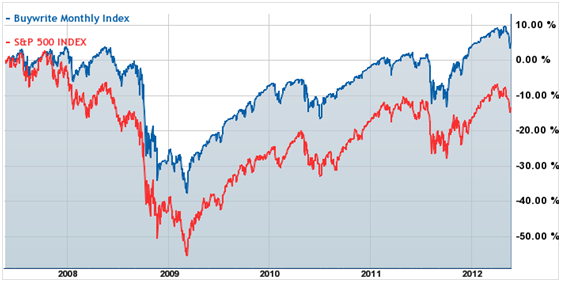Where can a yield-starved investor turn today without chasing dividends? Or should they just sit around waiting for bond yields to rise?
You may not be comfortable with the answer, but please hear me out for just one more minute.
I'm talking about covered calls. In order to take advantage of this options strategy, you do not – I repeat, DO NOT – need to trade options. In fact, you can use covered calls in a retirement account. Best of all, you can profit from covered calls using a regular old ETF.
But for some reason, self-directed investors seem to ignore what is, in my opinion, the best income strategy available today.
Why would you choose to ignore a strategy that has proven to outperform the major market benchmark S&P 500 (NYSE: SPY) by roughly 20% over the past five years? Just look at how the SPDR S&P 500 (SPX) and CBOE S&P 500 BuyWrite Monthly Index (BXM) have performed during that time.

In 2011, the BXM finished up 5.6%, while the SPX went nowhere. And as Barron’s noted earlier this year, other variations of the covered-call strategy – writing cash-secured puts, or covered calls on different indices – performed even better.
Granted, the 2011 market was tailor-made for hedged strategies. In a strong bull market, buy-write strategies will drastically underperform the broader market.
But let's face it – we're in a prolonged secular bear market in stocks. To ignore this fact is to ignore the strongest trend going.
In a bear market, the income from call options – the majority of which will expire unexercised – will provide some downside protection and index outperformance. But that option income will not overcome steep losses in the underlying equities.
At its heart, the goal of a covered-call strategy is to lower our cost basis by generating income through the selling of call options.
The Time Has Come
The time has come for the average investor – either wealthy or in the process of accumulating wealth – to consider using covered calls.
So what is a covered call?
Covered calls are an options strategy whereby an investor holds a long position in an asset and writes (sells) call options on that same asset in an attempt to generate increased income from the asset. The strategy is often employed when an investor has a short-term neutral to bearish view on the asset and for this reason decides to hold the asset (long) and simultaneously have a short position via the option to generate income from the option premium. Covered calls are also known as a "buy-write" strategy.
For example, let's say that you own shares of Wal-Mart (NYSE: WMT). You like the stock’s long-term prospects as well as its share price but feel in the shorter term the stock will likely trade relatively flat to lower, perhaps within a few dollars of its current price of, say, $63. If you sell a call option on WMT for $65, you earn the premium from the option sale but cap your upside. One of three scenarios is going to play out:
a) WMT shares trade flat (below the $65 strike price) – the option will expire worthless and you keep the premium from the option. In this case, by using the covered call strategy you have successfully outperformed the stock.
b) WMT shares fall – the option expires worthless, you keep the premium, and again you outperform the stock.
c) WMT shares rise above $65 – the option is exercised, and your upside is capped at $65, plus the option premium. In this case, if the stock price goes higher than $65, plus the premium, your covered call strategy has underperformed the WMT shares.
As I have often stated, most investors think of options as high-risk, speculative strategies where large losses can be incurred. While this is certainly true of some options strategies, covered calls are actually more conservative than investing in stocks or ETFs alone.
In other words, a covered call strategy is SAFER than buying a stocks or an ETF.
Why?
Because covered calls:
-
Provide some protection in a down market
-
Are one of few ways an index investor can achieve double-digit returns in a flat or slow-growth market
-
Lower your cost basis while decreasing the volatility of your portfolio
Remember, covered calls make money when stocks are slightly higher, flat or down. You only get the underlying stock "called" away if it rises significantly.
So again, why would any investor choose to shy away from such a proven income strategy that has outperformed the market and dividend-paying stocks over the long term?
As always, if you have any questions regarding covered calls or options in general please do not hesitate to email me at optionsadvantage@wyattresearch.com.
 Facebook
Facebook
 Twitter
Twitter